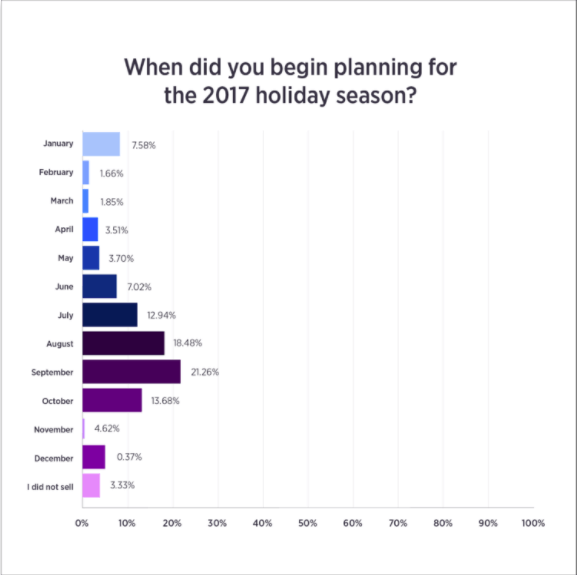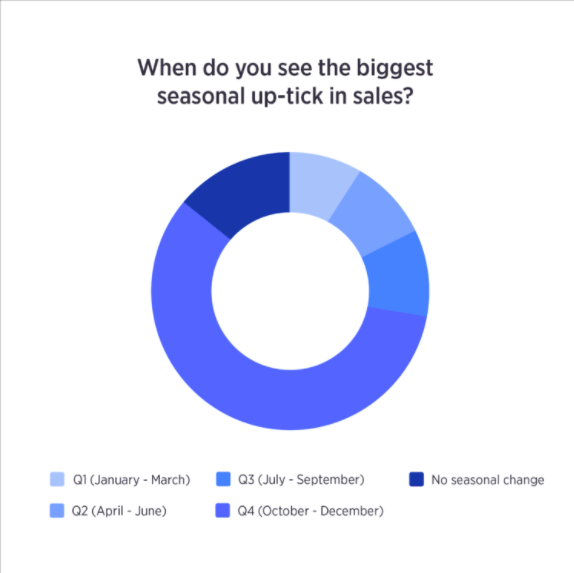‘Tis the Season to Sell: Some Ecommerce Tips for Holiday Marketing
The temperature is dropping, the leaves are falling, and all the other usual signs of changing seasons are upon us. In short, winter is coming, and the holiday shopping surge is coming along with it.
Deloitte’s annual holiday season forecast predicts that retail sales could exceed $1.10 trillion in the 2018 holiday season. Essentially, ecommerce is a key player in this story. It plays an ever-larger role from year to year, with online holiday sales this year expected to rise 22% over 2017’s season. That translates to an expected sum of $134 billion in ecommerce alone.
What’s more difficult to know at a glance is the nitty-gritty of how brands and businesses are updating their ecommerce marketing strategies to handle the shopping season on the horizon. In what follows, we’ll try to make these particular signs are little easier to read by tapping into vendors, marketers, brand managers, and other key players on the supply side to see what they expect and how they’re prepping for this year’s holiday blitz.
Ecommerce Basics
Gone are the days when the corner store where everyone knows your name represented the norm in retail or customer service. Like so many other facets of our everyday routines, buying and selling things has migrated online. This is true for B2B transactions where companies deal directly with each other. And it’s equally true of businesses that engage with the buying public one ordinary customer at a time.
Ecommerce is the catch-all term for using online platforms to do either of these things. It refers to the online buying and selling of goods and services. It embraces all the digital tools and methods that businesses use to attract and service buyers online, from payment processing, maintaining a customer database, hosting a webstore, completing transactions, and more.
Whatever you’re selling online, you’ll use the same basic multi-tool to do it. The digital platforms and shopping cart systems you use can handle all the nuts and bolts of ecommerce, including:
- Sending customers to payment gateways
- Offering them delivery options
- Capturing their billing and delivery addresses
- Calculating taxes
- Creating invoices and tracking numbers
Fortunately, setting up shop in this way no longer requires programming expertise or startup capital. Ecommerce services, which provide templates, hosting, and all the fixings, come in free and paid flavors. Popular examples include Shopify, Volusion, BigCommerce, and others.
The Numbers Don’t Lie
So how are ecommerce brands and businesses preparing for 2018’s holiday marketing campaigns?
BigCommerce surveyed more than 1,000 online brand marketers, managers, and business owners about what marketing decisions they made in 2017. From there, they dived into how that worked out and how it impacted their plans and expectations for the 2018 season.
This survey gathered information about a wide range of business operations and marketing decisions, including:
- The timing of seasonal sales upticks
- Holiday marketing campaign timelines
- Expected changes in revenue
- Preferred metrics for campaign success
- The ROI value of preferred marketing, advertising, and sales channels
As we’ll see, the survey found that the devil’s in the details: the success of a brand’s holiday marketing campaign relies on proper planning and execution. But it can’t hurt to break it down a little more. Here, in no particular order, are some of the (big) BigCommerce study’s findings and their bearing on 2018’s big holiday ecommerce push.
Holiday Preparation
BigCommerce found that the majority of brands surveyed began their 2017 holiday campaign planning in the third quarter of the year. September was the month chosen by the largest share of companies (over 1 in 5), followed by August and October, respectively. This approach seems to have produced mixed results. 1 in 3 of those surveyed reported that they changed their approach this year, beginning their 2018 holiday campaign preparations 1-4 months earlier than before.

Measuring Success
Without a good way to measure campaign success, there’s little hope of learning anything about the relative merits of different marketing strategies, timelines for preparation, and other key decisions brands have to make in the run-up to the holiday season. Since these decisions are what most directly impact revenue and performance from year to year, metrics matter.
There’s a wide assortment of digital tools for measuring campaign success. Which ones do businesses typically depend on for charting their progress? Depending on your preference, ecommerce platforms, marketing analytics tools, or accounting software might be the best place to house and measure your progress. It just takes finding the right tools for you and your company.
Seasonal Sales Spikes
Seasonality refers to seasonal changes in sales (up or down), and therefore in revenue, throughout the year. BigCommerce found that 15% of businesses do not experience seasonality. These are primarily B2B vendors or brands whose product lines, such as industrial hardware and office equipment, are not subject to fluctuating demands year-round. Among the majority of businesses that do experience seasonality, however, some patterns emerge.
For instance, it’s not surprising that over 56% of surveyed brands report a sales spike before and around the holidays in the fourth quarter of the year. Q4 is followed in high sales by the second quarter of the year around Mother’s Day and in the run-up to Summer.

Brands are overwhelmingly optimistic about what this year has in store:
- The vast majority (over 88%) of those surveyed report expectations of increased online holiday sales in 2018.
- 40% expect online sales to increase by more than 25%.
- Some (5.4%) even predict a 100+% increase in online sales this year.
These are bold numbers, but they’re what we should expect in light of the previous Deloitte forecast. It suggests that 2018’s holiday season is shaping up to be the biggest online sales event ever.
All Hands on Deck
For many years now, we’ve witnessed an explosive growth in the ecommerce economy. Last year, online sales passed a big milestone to account for fully one-tenth of total retail worldwide. The same research predicts that global ecommerce revenue may exceed $4 trillion by 2020, driven by well over 2 billion digital shoppers by the following year.
It’s natural to wonder whether those mind-boggling numbers are responsible for the downfall of brick-and-mortar retailers. Ultimately, it turns out that ecommerce has had the effect of driving retail job growth into new areas rather than depressing it overall.
In short, online businesses are hiring, with roughly 1 in 3 planning to bring new staff aboard for this year’s holiday season. Most of those brands intend to hire 1-5 new people.
The new blood will largely be spread over a few roles related to rapid response and meeting increased holiday demand for service. Over three-quarters of holiday hires will log hours on warehouse and fulfillment duty, with most of the rest tackling customer support.
Where the Action Is
Despite the massive global shift towards online shopping that we just reviewed, brick-and-mortar locations and their branded websites are still the epicenters of holiday shopping activity.
Branded sites are expected to take the lion’s share (64.66%) of holiday sales this year. Amazon continues to make its presence felt. In fact, it’s almost exactly tied with retail stores themselves as a sales destination (24.5% and 24.7%, respectively). Facebook is next in line with an expected market share of 17.47%.
That’s the sales side. How about advertising? What venues are shaping up to be the top holiday marketing channels for 2018?
This year Facebook has laid a milestone, finally beating out email campaigns as the top holiday marketing vehicle. But the social media megalith has only a razor-thin advantage, with email marketing the top choice of 51.2% of surveyed brands to Facebook’s 51.61%.
The runners-up this year, trailing in the 25-29% range, were Instagram, SEO, and Google Shopping.
In a telling sign of how deeply our lives as buyers have entered digital space, marketing and promoting brands via word of mouth received well under 10% support in BigCommerce’s survey.
Takeaway Tips
The numbers we’ve just covered paint an encouraging picture for ecommerce brands heading into the 2018 holiday shopping season. Let’s wrap up by breaking these big-picture trends and expectations down into some actionable tips to help your brand boost performance during the biggest sales event of the year.
Start Early
Starting early might be the single most effective thing brands can do to get ahead and stay ahead during the run-up to holiday sales. Advertising costs typically ramp up in the fourth quarter, so prepping as early as July and launching campaigns no later than October and November is the smart play.
It’s not just that costs increase in the Fall, but ad competition on social platforms like Facebook does, too. Fortunately, brands can do a lot to give themselves every advantage early on, from building email lists, attracting organic web traffic, and taking other steps to build an audience that can be retargeted during the holiday push.
Normal tricks might need to be tweaked with a seasonal frame of mind. Take SEO, for instance. Plenty of keywords and search terms are seasonal, and your approach to holiday SEO can and should reflect this.
Sell (Customers on) Your Brand
Business performance fundamentally depends on converting browsers into buyers. This is another area in which companies can have a big, direct impact on their bottom line, by demonstrating the value of their brand in real practical terms and cementing customer loyalty.
Responsiveness is of the essence here. Reach out on social channels to respond concretely to inquiries and concerns from followers. Making your brand available makes it visible. Modeling transparency with your audience also builds trust and confidence in the service behind your product.
But don’t wait for potential customers to reach out to you. As with the campaign prepping steps we just discussed, it pays to be pro-active.
Seek out your audience and promote awareness of your brand in their virtual habitats, whether on Instagram, YouTube, Facebook, or elsewhere. Make sure you’ve got a secure presence (a page or profile) on social platforms. Be sure and leverage them to engage by sharing industry news and other information.
Social engagement also gives you opportunities to learn. Poll your followers about what they want and expect, and about areas for improvement in your ground game. Share the results to keep the conversation alive.
Wrapping Up
Ecommerce is on the march, and we’ve seen what an outsized impact it’s having on how brands are doing business in 2018, which is expected to be a banner year for online sales.
Some of the key takeaways include the importance of planning and executing your holiday sales campaign on the early side; growing your audience early to build a foundation for holiday outreach; and focusing your marketing efforts in the right venues; and using the right metrics to measure success.
With these tools in hand, 2018 will be a year for the books.
Was this helpful?